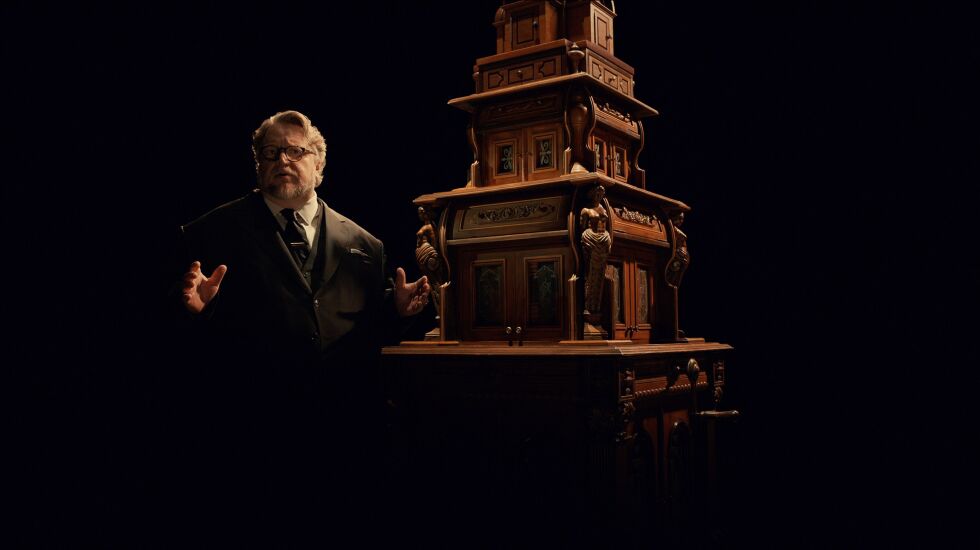
At the outset of each episode of “Guillermo del Toro’s Cabinet of Curiosities,” the great filmmaker and master of the macabre himself ambles into frame wearing an impeccable three-piece suit, holding a key that unlocks an intricately carved, multi-tiered cabinet filled with wondrous and weird art and curios and talismans. Prior to the episode titled “Pickman’s Model,” del Toro says, “Beauty is in the eye of the beholder — but what about the horror? We ascribe these visions to a feverish imagination, a whim, a folly, but what if they are not? What if they are a careful record, a warning. … Our tale tonight is ‘Pickman’s Model,’ and its director, Keith Thomas.”
At that point, del Toro places a miniature carving in the director’s likeness in front of a sketchbook of quite disturbing art, and let the episode begin. These intro sequences, which have echoes of “Alfred Hitchcock Presents” and the Rod Serling classic series “The Twilight Zone” and “Night Gallery,” are exquisite. They’re haunting. They’re weird. They’re fantastic.
As for the actual entries in this ambitious and magnificently staged eight-part Netflix series: While some episodes are more about delivering grotesquely disturbing imagery than well-earned scares, and at times the attention to creepy, gross-out visuals overwhelms the storylines and we’re more nauseated than genuinely horrified, this is a meticulously crafted, crisply written, beautifully directed and well-acted anthology series, sure to please fans of Arkham House publishing, “Weird Tales” magazine and the work of writers such as H.P. Lovecraft, Henry Kuttner and Michael Shea.
In fact, the aforementioned “Pickman’s Model” (available Thursday) is based on a short story by Lovecraft and was previously adapted into a 1971 episode of “Night Gallery.” Set in the early 19th century in and around the fictional Mitkatonic University in Massachusetts, the story centers on a young artist named Will (Ben Barnes) who is equally repulsed and mesmerized by the work of a mysterious, older painter named Richard Pickman (Crispin Glover), who literally works out of a cemetery and creates images so terrifying and haunting, the paintings seem to come to life, creating waking nightmares for Will. It’s a brilliantly constructed episode with echoes of “The Shining,” though Crispin Glover nearly sinks the entire thing with an over-the-top accent as he talks about descendants of his who were “boined at the stake” and says, “It’s the woild that’s mad, Will!”
Every episode features at least one familiar and talented character actor. In the premiere chapter, “Lot 36,” which is set in the early 1990s and is directed by Guillermo Navarro from a story by del Toro, the prolific and always compelling Tim Blake Nelson plays a war veteran who lost the hearing in one ear and saw his marriage crumble and is filled with racist hatred and disdain for humanity. He’s a skeezy, rude and selfish character who carves out a living buying up the contents of storage spaces left behind by people who are either dead, divorced or in debt. One such purchase yields a bounty that could be worth hundreds of thousands of dollars — but given the now-dead owner of those potential treasures seemed to have ties to the Nazi party as well as the occult, well, let’s just say the “Lot 36” storage space might not be such a bargain after all. (Like many episodes of “Cabinet,” this one features some incredible makeup, practical and special effects. Time and again, the series features creatures and sights so hideous you’ll regret even thinking about a snack while you watch.)

Some episodes give you a fairly major indication of what you’re about to witness, e.g., “Graveyard Rats” (also debuting Tuesday), which, like “Lot 36,” is about a greedy, grubby miscreant who sees the dead as an opportunity to make money. Then there’s “The Autopsy” (Wednesday), with F. Murray Abraham playing a medical examiner who is brought into a small town to determine the exact cause of death in an accident that killed nine men. With an early shot that brings to mind a certain infamous visual from “The Exorcist,” this particular episode combines some truly sickening imagery with a richly layered back story. (Each episode runs approximately an hour, and each has the look and production quality of a feature film.)
Some episodes are more effective than others. “The Outside” (Wednesday) has a kind of “Don’t Worry Darling” vibe, with a better payoff. It’s genuinely memorable. Not so much with “Dreams of the Witch House” (Thursday), which, despite a game performance by Rupert Grint of “Harry Potter” fame, is borderline campy in its execution. On balance, though, this is a suitably grisly and nightmarish feast for fans of the sinister and the supernatural.







